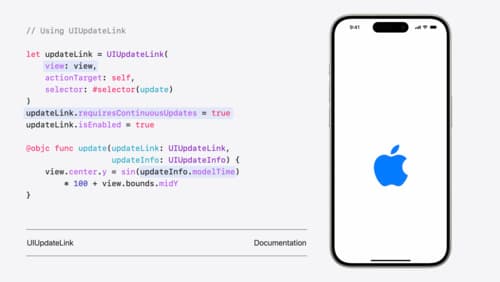How can I migrate an MVVM application to Swift 6?
Asked on 2024-08-02
1 search
To migrate an MVVM application to Swift 6, you can follow the guidance provided in the Migrate your app to Swift 6 session from WWDC 2024. Here are the key steps:
-
Enable Swift 6 Language Mode:
- Start by enabling the Swift 6 language mode in your project settings. This will help you take advantage of the new features and improvements in Swift 6, including compile-time data race safety.
-
Concurrency Checking:
- Enable complete concurrency checking for each target in your project. This is a per-module setting that leaves your project in Swift 5 mode but enables warnings for code that would fail with Swift 6's enforced data isolation. This step helps identify and resolve potential concurrency issues.
-
Resolve Warnings:
- Go through the warnings generated by the concurrency checking and resolve them. The compiler diagnostics will guide you towards the places that need fixing, acting like a pair programmer pointing out potential bugs in your code.
-
Enable Swift 6 Mode:
- Once all warnings for a target are resolved, enable Swift 6 mode for that target. This locks in all changes and prevents future refactorings from regressing to an unsafe state.
-
Repeat for All Targets:
- Repeat the process for each target in your project. This ensures that all parts of your application are migrated to Swift 6 safely.
-
Refactor for Safety:
- After enabling Swift 6 mode for all targets, consider doing some whole-app refactoring to ensure that your codebase fully benefits from Swift 6's concurrency features and data isolation guarantees.
For more detailed guidance, you can watch the Migrate your app to Swift 6 session, which provides a step-by-step walkthrough of the migration process.
Additionally, the What’s new in SwiftUI session highlights that SwiftUI views are now implicitly isolated to the main actor by default, which can simplify your migration if you were previously marking your views with the main actor annotation.
Relevant Sessions:

What’s new in UIKit
Explore everything new in UIKit, including tab and document launch experiences, transitions, and text and input changes. We’ll also discuss better-than-ever interoperability between UIKit and SwiftUI animations and gestures, as well as general improvements throughout UIKit.

What’s new in SwiftUI
Learn how you can use SwiftUI to build great apps for any Apple platform. Explore a fresh new look and feel for tabs and documents on iPadOS. Improve your window management with new windowing APIs, and gain more control over immersive spaces and volumes in your visionOS apps. We’ll also take you through other exciting refinements that help you make expressive charts, customize and layout text, and so much more.

SwiftUI essentials
Join us on a tour of SwiftUI, Apple’s declarative user interface framework. Learn essential concepts for building apps in SwiftUI, like views, state variables, and layout. Discover the breadth of APIs for building fully featured experiences and crafting unique custom components. Whether you’re brand new to SwiftUI or an experienced developer, you’ll learn how to take advantage of what SwiftUI has to offer when building great apps.
